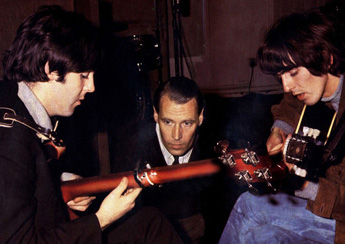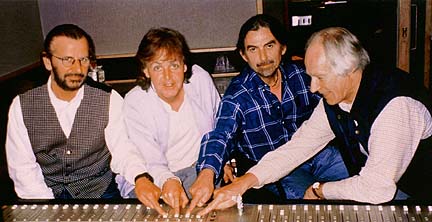|

|
|
George Martin in the studio
|
Sir George Martin is widely acclaimed by both his fans and his peers
as the most influential and prolific record producer in history. His
overwhelming commercial success -- with an astonishing thirty number
one UK hits under his belt -- remains unparalleled. No other producer has
enjoyed a track record as creative or as versatile, as Sir George has
produced over 700 recordings in a career spanning almost 50 years,
and encompassing genres as diverse as jazz, blues, metal, avant-garde,
classical, comedy, and film soundtracks. Although today frequently
ascribed the title of the elusive "Fifth Beatle," Sir Georgeís life
story began far from the clamour of the music industry.
George Martin was born on 3 January 1926, in Holloway, North London,
growing up with no formal musical training. However, the young George
taught himself to play piano by ear, and by the age of sixteen was
actively involved in his own school dance band. From 1943, he served
with the British Fleet Air Arm as an observer in planes, and rose to
the rank of Lieutenant. Paul McCartney later credited George Martinís
legendary composure to his time in military service, explaining, "He
pulled it all together, you're ultimately responsible, you're the
captain. I think that's where George got his excellent bedside manner.
He'd dealt with navigators and pilots...he could deal with us when we
got out of line."
|

|
|
George Martin
|
Having been demobbed in 1947, George gained a place in London's
Guildhall School of Music, where he studied composition and classical
music orchestration, at the same time developing his talents in the
piano and the oboe. After graduating, George officially entered the
music industry in 1950, when he was hired as assistant to the then head
of Parlophone Records, and was soon made responsible for overseeing the
classical recordings for the label, which was an offshoot of the EMI
Group. Over the years, George established himself as a jazz and light
music producer, working with such names as Cleo Laine, Stan Getz, John
Dankworth, Humphrey Lyttelton and Judy Garland. Yet he was eager to
seek out new recording markets, and produced a string of hit comedy
records with legends of British humour, including Peter Ustinov,
Bernard Cribbins, Peter Cook, Dudley Moore, and, most notably, the
Goons.
In 1955, at the age of twenty-nine, he was appointed head of
Parlophone, so becoming one of the youngest people ever to take the
helm of a record label. In the early 1960s, he was keen to acquire
successful pop artists, just as the Beatles' manager, Brian Epstein,
was anxiously seeking a recording contract on behalf of the band.
Having been turned down by major British labels Decca, Pye, Phillips,
and even EMI itself, Brian approached George Martin, who at length drew
up a recording contract, provisional upon the outcome of an audition
set for 6 June, 1962.
|

|
|
The Beatles and George Martin,
manager Brian Epstein's "dream of a team"
|
When The Beatles first set foot in EMI's Abbey Road studio for
their recording test, history was in the making. Balance engineer
Norman Smith recalls the events of the evening: "At the end of it all
George Martin said that we had been talking to them for quite some
time...and was there anything they didn't like. George Harrison
looked up and said to George, 'I don't like your tie.' I still
maintain that was the turning point...They didnít stop talking for an
hour or more after that...they were so funny and had so much wit, we
couldnít stop laughing." George Martin impressed the Beatles, in turn,
when it was revealed that he had produced the solo comedy records of
Goons members Spike Milligan and Peter Sellers, whose surreal humour
had long been admired by John and George, in particular.
Having been satisfied, therefore, that the Beatles had fine pop
potential, with their vocal harmonies and tremendous charisma,
George Martin finalised the deal which was to be a turning point in
music history, and Brian Epstein declared in his autobiography that
"from that moment on they have been a dream of a team." In the years to
come, Martin would produce not only the Beatles, but numerous other
Merseyside artists under the wing of Brian Epstein, including Cilla
Black, Gerry and the Pacemakers, and Billy J. Kramer. In 1963, records
produced by George Martin held the number one position on the British
charts for an unprecedented 37 weeks of the year.
|

|
|
George Martin runs through a number with Paul and George
|
Such heights of innovation and success could scarcely be imaginable had
Brian Epstein not brought the Beatles to George Martin. It may have
seemed an unlikely partnership at first -- a classically-trained,
thirty-six-year-old Martin and four rough-edged lads from
Liverpool -- but the relationship bloomed. In the words of Beatles
biographer Ray Coleman, it was one which "began as record producer and
young pop stars and then developed into that of a wise uncle, and
eventually to friendship." When George Martin himself released an album
of orchestral Beatles music in 1964, John Lennon penned the sleeve note:
"Some of the sounds on the album may be new to you (and me), that's
'cause George has a great habit of matching unlikely instruments
together (like a Jew's harp and a twelve-stringed finger) but the
results are great and I think he should get a raise."
In their first years together, George Martin directed the Beatles'
recording sessions, guiding their early sound, and on his suggestion,
their first number one disc in the UK, "Please Please Me," was
transformed from its original incarnation as a slow, Roy Orbison-style
ballad into an upbeat, commercially popular hit single. In years to
follow, his classical influence would grow increasingly prevalent among
the recordings, and shone through again in such tracks as "Eleanor
Rigby," "In My Life" with its baroque-style middle eight, the classic
crescendo of "A Day In The Life," and Yellow Submarine's
"Pepperland Suite." However, growing disgruntled with EMI, George
Martin left the firm at one point to form an independent production
company called Associated Independent Recordings (AIR). EMI could well
have assigned the Beatles another producer, but it was clear to all
involved that such a successful team should not be divided, and Martin
remained with the Fab Four throughout almost their entire career.
|

|
|
George Martin with Ringo, Paul and George
in the studio, creating "The Beatles Anthology"
|
Beatles Historian Mark Lewisohn affirms that "George Martin was the
perfect producer for the group -- creative, keen to experiment,
willing to listen, an expert about music but nicely inexperienced in
pop and rock, and a veteran of comedy-sound effects records." Indeed,
George's experience with the Goons had provided him with a diverse
repertoire of recording trickery, which came into play when the
Beatles, worn by the pressures of live performance and touring,
progressed in the studio to ever more complex tracks, including
"Tomorrow Never Knows" and "I Am The Walrus." The creation of such
masterpieces called for a mutual understanding between producer and
artists, a partnership in which Martin's patient nature was invaluable.
Musician Peter Asher, brother of Paul McCartney's former girlfriend
Jane, and one half of Peter & Gordon, saluted Martin: "The Beatles were
brimming over with brilliant ideas and radical concepts but it took
extraordinary diplomacy, exceptional musical expertise, limitless
patience and visionary clarity to bring these ideas to fruition and
greatness. Sometimes George's genius was knowing when to jump in and
offer musical advice; sometimes it was knowing when to go down to the
canteen and have a cup of tea, letting them get on with whatever they
were up to."
|

|
|
Sir George during the recording of the "In My Life" album
|
To this day, George Martin remains an active and energetic figure on
the music scene. Even after the Beatles broke up in 1970, he stayed a close friend and colleague, and has worked on at least one album for all four solo Beatles, including nine for Paul McCartney. Throughout the 70s, 80s and 90s he was much in demand as a producer, arranger and conductor for such diverse artistes as Jeff Beck, America, Elton John, Jose Carreras, Celine Dion, Little River Band, Cheap Trick and Ultravox. In 1987, he produced and presented a documentary to mark the 25th anniversary of Sgt. Pepper's Lonely Hearts Club Band, winning a Palme at the Cannes Film Festival. He also produced and directed the Beatles Anthology albums in 1995, and was the first of the Beatles clan to be honoured with a knighthood, in 1996. The following year, he oversaw a benefit concert -- involving such music names as Paul McCartney, Eric Clapton, Elton John, and Sting -- for the people of the volcano-ravaged island of Montserrat, where an outpost of his AIR Studios had formerly been based. In 1998, Sir George released In My Life, an album of Beatles covers performed by world-famous musicians and actors, debuted his popular The Rhythm of Life 3-part documentary series, in which he explored the whys and wherefores of music, and was named the British Phonographic Industry's "Man of the Year." He has won six Grammys, including the Lifetime Achievement Award, and was inducted into the Rock'n'Roll Hall of Fame alongside Sir Paul McCartney in early 1999. Sir George continues to tour the globe, conducting performances of his own orchestral arrangements, and presenting multimedia lectures on The Making of Sgt. Pepper. He announced that one of his final studio endeavours would be producing and scoring Elton John's Candle In The Wind '97, a tribute to the late Princess Diana. "It became my last No.1, and probably my last single," he said. "It's not a bad one to go out on." However, in 2000 he returned to produce the hugely successful 1 album, a compilation of the Fab Four's number one hits, watching the Beatles soar to the top of the charts yet again. In 2001 he released Produced By George Martin: 50 Years In Recording, a lavish 6CD retrospective of his entire studio career, and in 2002, he launched Playback, his limited-edition illustrated autobiography.
|





